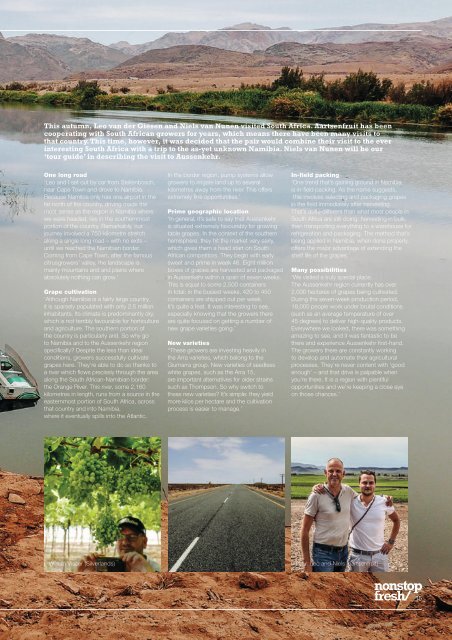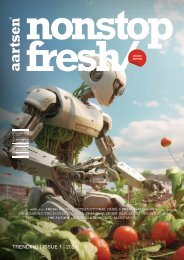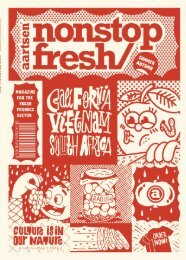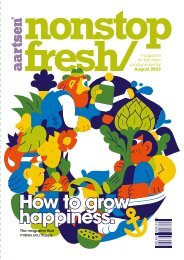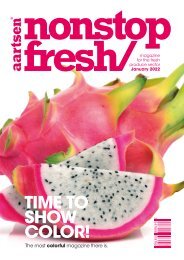You also want an ePaper? Increase the reach of your titles
YUMPU automatically turns print PDFs into web optimized ePapers that Google loves.
This autumn, Leo van der Giesen and Niels van Nunen visited South Africa. Aartsenfruit has been<br />
cooperating with South African growers for years, which means there have been many visits to<br />
that country. This time, however, it was decided that the pair would combine their visit to the ever<br />
interesting South Africa with a trip to the as-yet unknown Namibia. Niels van Nunen will be our<br />
‘tour guide’ in describing the visit to Aussenkehr.<br />
One long road<br />
‘Leo and I set out by car from Stellenbosch,<br />
near Cape Town and drove to Namibia.<br />
Because Namibia only has one airport in the<br />
far north of the country, driving made the<br />
most sense as the region in Namibia where<br />
we were headed, lies in the southernmost<br />
portion of the country. Remarkably, our<br />
journey involved a 750-kilometre stretch<br />
along a single long road – with no exits –<br />
until we reached the Namibian border.<br />
Coming from Cape Town, after the famous<br />
citrusgrowers’ valley, the landscape is<br />
mainly mountains and arid plains where<br />
absolutely nothing can grow.’<br />
Grape cultivation<br />
‘Although Namibia is a fairly large country,<br />
it is sparsely populated with only 2.5 million<br />
inhabitants. Its climate is predominantly dry,<br />
which is not terribly favourable for horticulture<br />
and agriculture. The southern portion of<br />
the country is particularly arid. So why go<br />
to Namibia and to the Aussenkehr region<br />
specifically? Despite the less than ideal<br />
conditions, growers successfully cultivate<br />
grapes here. They’re able to do so thanks to<br />
a river which flows precisely through the area<br />
along the South African-Namibian border:<br />
the Orange River. This river, some 2,160<br />
kilometres in length, runs from a source in the<br />
easternmost portion of South Africa, across<br />
that country and into Namibia,<br />
where it eventually spills into the Atlantic.<br />
In the border region, pump systems allow<br />
growers to irrigate land up to several<br />
kilometres away from the river. This offers<br />
extremely fine opportunities.’<br />
Prime geographic location<br />
‘In general, it’s safe to say that Aussenkehr<br />
is situated extremely favourably for growing<br />
table grapes. In the context of the southern<br />
hemisphere, they hit the market very early,<br />
which gives them a head start on South<br />
African competitors. They begin with early<br />
sweet and prime in week 46. Eight million<br />
boxes of grapes are harvested and packaged<br />
in Aussenkehr within a span of seven weeks.<br />
This is equal to some 2,500 containers<br />
in total; in the busiest weeks, 420 to 450<br />
containers are shipped out per week.<br />
It’s quite a feat. It was interesting to see,<br />
especially knowing that the growers there<br />
are quite focused on getting a number of<br />
new grape varieties going.’<br />
New varieties<br />
‘‘These growers are investing heavily in<br />
the Arra varieties, which belong to the<br />
Giumarra group. New varieties of seedless<br />
white grapes, such as the Arra 15,<br />
are important alternatives for older strains<br />
such as Thompson. So why switch to<br />
these new varieties? It’s simple: they yield<br />
more kilos per hectare and the cultivation<br />
process is easier to manage.’<br />
In-field packing<br />
‘One trend that’s gaining ground in Namibia<br />
is in-field packing. As the name suggests,<br />
this involves selecting and packaging grapes<br />
in the field immediately after harvesting.<br />
That’s quite different than what most people in<br />
South Africa are still doing: harvesting in bulk,<br />
then transporting everything to a warehouse for<br />
refrigeration and packaging. The method that’s<br />
being applied in Namibia, when done properly,<br />
offers the major advantage of extending the<br />
shelf life of the grapes.’<br />
Many possibilities<br />
‘We visited a truly special place.<br />
The Aussenkehr region currently has over<br />
2,000 hectares of grapes being cultivated.<br />
During the seven-week production period,<br />
18,000 people work under brutal conditions<br />
(such as an average temperature of over<br />
45 degrees) to deliver high-quality products.<br />
Everywhere we looked, there was something<br />
amazing to see, and it was fantastic to be<br />
there and experience Aussenkehr first-hand.<br />
The growers there are constantly working<br />
to develop and automate their agricultural<br />
processes. They’re never content with ‘good<br />
enough’ – and that drive is palpable when<br />
you’re there. It is a region with plentiful<br />
opportunities and we’re keeping a close eye<br />
on those chances.’<br />
Willem Visser (Silverlands)<br />
f.l.t.r. Leo and Niels (aartsenfruit)<br />
nonstop<br />
fresh/ 15


